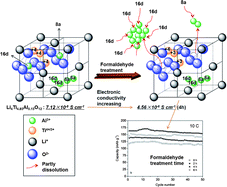A novel method to enhance rate performance of an Al-doped Li4Ti5O12electrode by post-synthesis treatment in liquid formaldehyde at room temperature
Abstract
An amenable method for improving rate performance of Li4Ti4.85Al0.15O12

* Corresponding authors
a
State Key Laboratory of Materials-Oriented Chemical Engineering, College of Chemistry & Chemical Engineering, Nanjing University of Technology, No. 5 Xin Mofan Road, Nanjing 210009, P.R. China
E-mail:
shaozp@njut.edu.cn
b Department of Chemical Engineering, Monash University, Clayton 3800, Australia
An amenable method for improving rate performance of Li4Ti4.85Al0.15O12

 Please wait while we load your content...
Something went wrong. Try again?
Please wait while we load your content...
Something went wrong. Try again?
R. Cai, S. Jiang, X. Yu, B. Zhao, H. Wang and Z. Shao, J. Mater. Chem., 2012, 22, 8013 DOI: 10.1039/C2JM15731D
To request permission to reproduce material from this article, please go to the Copyright Clearance Center request page.
If you are an author contributing to an RSC publication, you do not need to request permission provided correct acknowledgement is given.
If you are the author of this article, you do not need to request permission to reproduce figures and diagrams provided correct acknowledgement is given. If you want to reproduce the whole article in a third-party publication (excluding your thesis/dissertation for which permission is not required) please go to the Copyright Clearance Center request page.
Read more about how to correctly acknowledge RSC content.
 Fetching data from CrossRef.
Fetching data from CrossRef.
This may take some time to load.
Loading related content
